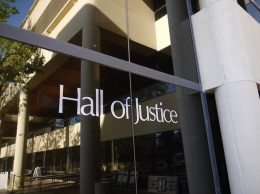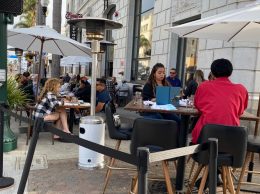Ventura and San Luis Obispo counties have more robust systems than Santa Barbara County for helping poor people who cannot afford legal help find a lawyer willing to take on their case.
In both counties, local bar associations oversee systems that take in requests from the poor and, if the issue can’t be resolved, assign a case to hundreds of lawyers who have indicated a willingness to volunteer.
Many lawyers also volunteer with independent legal aid services in the two counties. While those involved in what is known as pro bono work say their county’s legal needs are far from being met — there are still thousands of poor individuals who need help for every one lawyer who volunteers — Ventura and San Luis Obispo counties appear to have better participation rates than Santa Barbara County, with attorneys at the biggest firms working directly with the indigent on a regular basis.
On Aug. 9, the Business Times published an inquiry into the state of pro bono services in Santa Barbara County by Mission and State, a nonprofit, public-interest publication in Santa Barbara.
The California State Bar Association recommends lawyers engage in 50 hours of free work per year either directly with the poor or organizations that work with the poor. That investigation found that while many Santa Barbara County firms volunteer free services to nonprofit organizations that serve the poor, few of those firms count that work toward billable hours quotas and few attorneys take on the work of representing the poor directly.
In Ventura County, the Ventura County Bar Association has run the Volunteer Lawyer Services Program since 1996. The program has fielded more than 10,500 calls. On average, about 55 attorneys take a pro bono case each year, according to the bar association. “The need was great, and it was obvious that something needed to happen,” said David Shain, a lawyer with Ventura County’s largest firm, Ferguson Case
Orr Paterson who co-founded the service with Roger Myers, a partner in the county’s second-largest firm, told the Business Times.
The county bar brings in retired volunteer lawyers to field calls. If those lawyers determine that the caller can’t afford a lawyer and that the case has merit, it gets assigned to volunteer attorneys. Among attorneys, one of the most common reasons cited for not working directly with the poor is the matter of expertise — most of the needs from the poor involve family law disputes, landlord-tenant disputes and civil rights. The Ventura County service breaks cases into discrete parts so that lawyers who are willing to help on at least part of a case but don’t feel confident taking a whole case can still volunteer. “A person might be involved in litigation and have a hearing coming up,” Shain said. “The pro bono attorney might come on just to handle that particular hearing.”
In San Luis Obispo County, the bar association has established the SLO Law Line. Attorney Neil Tardiff runs the law line from his office, where trained interns from Cal Poly San Luis Obispo to handle incoming calls. Tardiff also coordinates with other attorneys.
“There are about 800 registered attorneys in our county, and we’ve reached out every single one. We’ve gotten about a 20 percent response rate, which is really incredible,” Tardiff said. “I have a list of over 100 lawyers right now who have agreed to handle some telephone time or even handle a case if it fits their expertise.”
Many firms do not have formal pro bono policies and do not track pro bono hours. Among the firms the Business Times contacted that do track pro bono hours, none said they counted toward billable hours quotas.
However, not all non-billable hours are created equal. Andre, Morris & Buttery, which has offices in Santa Maria and San Luis Obispo, said it does have a formal policy encouraging pro bono work. It also tracks pro bono hours as non-billable. But the firm’s structure calls for two categories of non-billable hours for its attorneys: less valuable work such as administration, and more valuable work such as promoting the firm to potential clients. Pro bono work falls into the more favorable category. “We see them the same way,” said Michael Morris. “Part of the business of being a lawyer is that you need to be promoting the firm and you need to be doing pro bono work.”
Tracked or not, attorneys at the area’s largest firms do log pro bono hours, some of them above the 50-hour recommendation.
Gregory J. Ramirez of Myers, Widders, Gibson, Jones & Feingold said he spends about 20 hours a month acting as general counsel for the county’s chapter of the National Association for the Advancement of Colored People. “Many times at the monthly meetings, people come in with concerns or complaints, whether it’s housing, or being harassed by the police or discrimination. We set up a time to meet with them on a monthly basis,” Ramirez said.
Many lawyers also volunteer to help guide the poor through the legal system before disputes erupt into full-blown cases. Leslie McAdam, one of a number of attorneys who have been recognized by the state bar for their commitment to Santa Clara Valley Legal Aid in Fillmore, spends about 60 hours a year helping the poor directly. She recalls helping a woman who was wrongfully evicted win back $300 from a deposit.
“I’m visiting her in her new apartment. There’s no furniture, and there are bottles outside that are clearly for recycling because that’s a source of income,” McAdam said. “Handing this lady a check was a big deal. I left there feeling, ‘wow, I’ve actually done something.’ ”
Legal aid groups are few and far between, with many having disappeared when federal funding dried up in the late 1990s and early 2000s. In Ventura County, California Rural Legal Assistance does maintain an office, but the need outstrips supply.
The Conejo Free Clinics provide a monthly session to help guide people through legal processes with volunteer attorneys. The Santa Clara Valley Legal Aid group is unique in that it uses only volunteer lawyers and survives solely on donations from the legal community rather than government funding.
Laura Bartels, executive director of the group, said its attorneys do take cases home with them. But for the most part, the most effective use of limited resources is giving guidance so that problems do not become lawsuits.
“We are more focused on the self help aspect of it,” Bartels said. “We will help people fill out forms and them what to do. We have an educational component built into our advocacy.”
In San Luis Obispo County, many firms work with nonprofit groups that provide legal guidance on topics from women dealing with domestic violence who need advice on obtaining restraining orders to consulting with senior citizens. Collette Hillier of Andre, Morris & Buttery volunteers monthly through the San Luis Obispo Legal Alternatives Corp. to consult with seniors on everything from wills to landlord-tenant disputes. “We’ve come into circumstances where there’s elder abuse or elder financial abuse,” she said. “Oftentimes seniors need a little more guidance. Most of them can’t pay for the services they need, and we try to give them what they need.”
Other firms maintain nonprofit involvement. While San Luis Obispo’s Sinsheimer Juhnke McIvor & Stroh does not tend to represent individual clients, partner Dave Juhnke was a co-founder of Friends of Prado Day Center, a nonprofit that serves the homeless.
By far the biggest source of pro bono work is counsel to nonprofits. Whether it’s resolving a lease dispute for a small church or revising an employment handbook for a group that helps the homeless, attorneys argue this work shouldn’t be discounted because it allows those nonprofits to spend scarce capital on programs for the indigent rather than legal bills. “Nonprofits are particularly at risk when it comes to employment law issues, because they don’t necessarily have the resources readily available to monitor ongoing legal compliance and yet, they are not excused from California’s burdensome employment laws, and have more to lose when problems arise,” Karen Gabler of Camarillo-based Light|Gabler said in an email.
While Ventura and San Luis Obispo counties have better developed infrastructure for handling pro bono cases, Ramirez said more volunteer lawyers are still desperately needed.
“You’ll never be able to address the full need, especially now that you see the middle class disappearing,” he said. “Middle class people can’t even afford a lawyer when they need a divorce or something tragic happens, like being denied their insurance coverage. Unless you can pay $500 an hour, can’t get access to justice.”






 Print
Print Email
Email
















